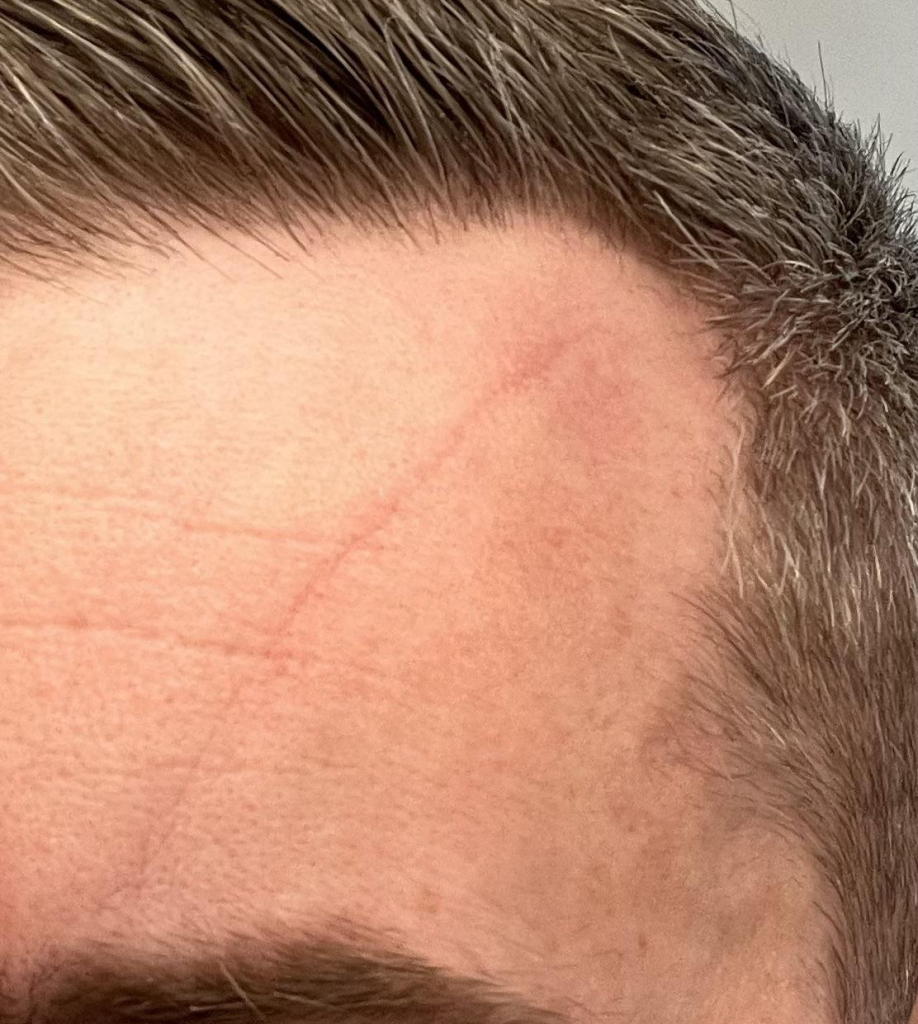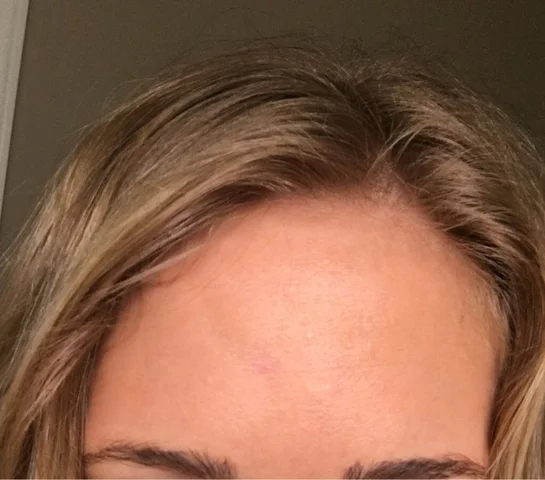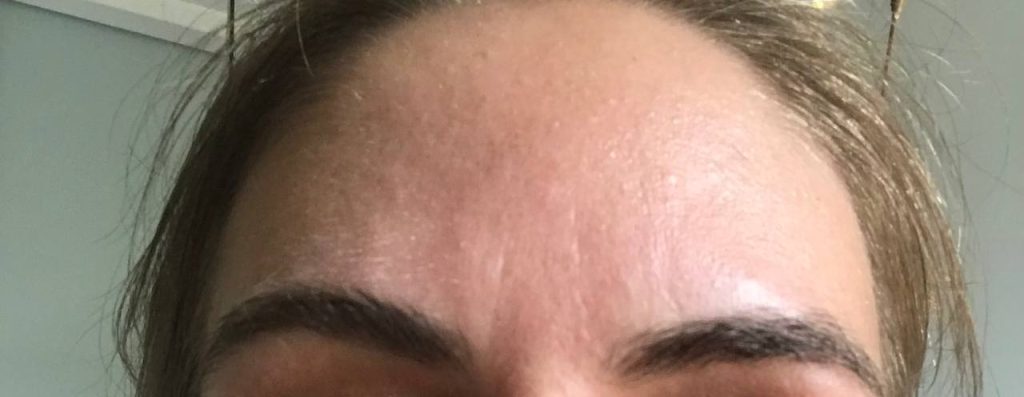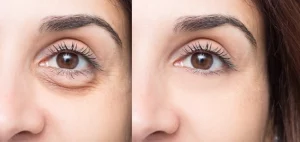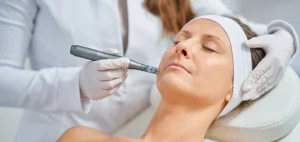What are vertical lines on the forehead?
Vertical lines on the forehead are up-and-down wrinkles that typically appear in the glabellar region, the area between the eyebrows. These are commonly referred to as frown lines, glabellar lines, or “11 lines”, and are primarily caused by repeated activation of the corrugator and procerus muscles involved in expressions like frowning, concentrating, or squinting.
Over time, these repeated facial movements fold the skin, and as collagen and elastin levels decline with age, the skin loses its ability to bounce back making lines more permanent.
Vertical forehead lines usually begin as dynamic wrinkles (visible only during expression) and may evolve into static wrinkles (visible even at rest) with age and muscle overuse.
A single vertical line can sometimes form due to asymmetrical facial habits, such as favoring one side when frowning or consistently sleeping on one side of the face. In some cases, a midline vertical crease (directly in the center) may be linked to poor posture, chronic stress, or brow tension.
It’s also important to differentiate a true wrinkle from a vertical dark line on the forehead, which may instead represent pigmentation (such as melanin deposits or post-inflammatory hyperpigmentation from friction, acne, or sun exposure). Unlike a crease, this type of line does not involve structural folding of the dermis.
Contributing factors that worsen vertical forehead lines include:
- UV exposure
- Genetics
- Dehydration
- Smoking
- Eye strain
- Stress
- Sleep compression
If a new vertical line appears suddenly or deepens rapidly especially when accompanied by headaches or vision changes it may be worth seeking clinical evaluation.
What Causes Forehead Lines?
Forehead lines form due to a combination of muscle activity, environmental exposure, and lifestyle factors that impact skin health over time. The main causes include:
- Facial Expressions: Repetitive movements like frowning, raising eyebrows, or squinting activate the frontalis, corrugator, and procerus muscles, gradually etching lines into the skin.
- Sun Exposure: Ultraviolet (UV) rays degrade collagen and elastin, reducing skin firmness and accelerating wrinkle formation—especially in unprotected skin.
- Genetics: Your genetic makeup can influence how early and how deeply forehead lines appear, particularly if you inherit thin skin or strong expressive muscles.
- Aging: As we age, the skin produces less collagen and hyaluronic acid, leading to loss of elasticity and volume, making lines more visible.
- Smoking: Nicotine impairs blood flow and collagen production, causing premature skin aging and deeper wrinkles, especially around the forehead and mouth.
- Alcohol: Alcohol dehydrates the skin and can impair nutrient absorption, weakening skin barrier function and accelerating wrinkle formation.
- Dehydration: Lack of adequate hydration makes skin more prone to fine lines and reduces its ability to bounce back from expression-induced creases.
- Diet: Diets high in sugar and low in antioxidants can contribute to glycation, a process that stiffens collagen fibers and promotes wrinkling.
- Stress: Chronic stress increases cortisol levels, which can impair skin regeneration, dehydrate the skin, and intensify habitual expressions like frowning.
- Lifestyle Choices: Poor sleep habits, lack of physical activity, and environmental pollutants all contribute to earlier and more pronounced forehead lines.
- Skin Care: Inadequate or harsh skin care routines—especially neglecting sunscreen and moisturizers—can accelerate skin aging and worsen forehead wrinkles.
What Are the Types of Forehead Lines?
Forehead lines can be classified based on their direction, depth, and cause. Understanding the different types helps in choosing the most effective treatments and setting realistic expectations for prevention or reversal.
1. Horizontal Forehead Lines
- These run across the forehead, from temple to temple.
- Caused primarily by repeated lifting of the eyebrows (frontalis muscle activity).
- Often associated with expressions of surprise or attentiveness.
- Typically one of the earliest types of lines to appear.
2. Vertical Forehead Lines (Frown Lines / “11 Lines”)
- Appear as one or two vertical creases between the eyebrows.
- Caused by frowning, squinting, or intense focus, involving the corrugator and procerus muscles.
- Commonly referred to as “11 lines”, these are among the most treated wrinkles with Botox and other neuromodulators.
3. Static Lines
- These are visible even when the face is at rest.
- Develop over time due to repetitive motion, loss of collagen, and skin thinning with age.
- More difficult to treat than dynamic lines and may require fillers or laser resurfacing.
4. Dynamic Lines
- Only appear during facial expressions like smiling or frowning.
- Caused by muscle movement and are usually the first stage of wrinkle formation.
- Can often be managed early with skincare and preventive Botox.
5. Deep Forehead Creases
- These are pronounced grooves that may span both horizontally and vertically.
- Often caused by years of cumulative sun damage, aging, and lifestyle factors like smoking or stress.
- May require a combination of treatments (Botox, fillers, laser, resurfacing).
6. Pigmented Lines (Mimicking Wrinkles)
- Sometimes mistaken for deep creases, dark vertical lines on the forehead may be pigmentation rather than true folds.
- Common in cases of sun damage, melasma, or skin irritation.
7. Sleep or Compression Lines
- Appear due to consistent sleeping positions, especially side-sleeping.
- Typically diagonal or curved lines on the forehead and cheeks.
- Repetitive pressure on the skin over time causes lasting creases.
Type | Location | Muscle Involved | Common Trigger |
Horizontal Lines | Across forehead | Frontalis | Raising eyebrows |
Vertical Lines (11 lines) | Between brows | Corrugator, Procerus | Frowning |
Sleep Lines | Diagonal | External pressure | Side sleeping |
Pigmentation Lines | Can mimic vertical lines | None (pigment-based) | Sun damage / melasma |
How to Get Rid of Forehead Lines?
Treatment | Best For | Typical Longevity | Typical Dose/Units | Typical Cost (USD) |
Botox (onabotulinumtoxinA) | Dynamic/‘11’ lines from frowning; mild–moderate horizontal lines | 3–6 months | Forehead patterns ~10–30 units (individualized) | $300–$600 per area |
Dysport (abobotulinumtoxinA) | Same as Botox; some prefer for broader spread | 3–5 months | Forehead/glabella commonly 40–60 units (different unit scale) | $300–$600 per area (varies) |
Daxxify (daxibotulinumtoxinA) | Dynamic glabellar lines with desire for longer duration | 6–9 months | Clinician-dosed; unit scale differs | Typically higher than Botox/Dysport |
Dermal Fillers (Hyaluronic Acid) | Static/deep lines present at rest; volume deficits (used cautiously in forehead) | 6–12+ months (product dependent) | By syringe (0.5–1.0 mL increments) | $500–$1,000 per syringe |
RF Microneedling | Fine/static lines; texture; laxity (all skin types) | Cumulative; maintenance every 6–12 months | 3 sessions commonly (4–6 weeks apart) | $300–$700 per session |
Laser Resurfacing (fractional) | Texture, deeper lines, sun damage | Long-lasting; maintenance annually/biennially | Often 1–3 sessions (device-dependent) | $800–$2,500+ per session |
Chemical Peels (superficial–medium) | Fine lines, dullness, pigment | Series-based; maintenance monthly/quarterly | Series of 3–6 (agent/strength dependent) | $150–$400 per peel |
Topical Skincare (retinoids, peptides, HA, antioxidants, SPF) | Prevention, fine lines, supporting in-clinic results | Ongoing with adherence | Nightly retinoid; daily SPF; HA/peptides per label | $20–$150 per product |
Forehead lines can be managed through a combination of clinical procedures, skincare products, and lifestyle choices. Each treatment option targets different types of lines dynamic, static, or those caused by environmental and behavioral factors. Below is a breakdown of the most effective treatments with detailed descriptions.
1. Neuromodulators (Botox, Dysport)
Neuromodulators are injectable treatments that work by blocking nerve signals to specific facial muscles, temporarily stopping them from contracting. This softens existing dynamic lines and prevents new ones from forming. The most commonly treated areas include the glabella and forehead.
- Onset: 2–7 days
- Duration: 3–6 months
- Units: 10–30 botox units depending on muscle strength and facial anatomy
- Best for: Vertical “11” lines, horizontal forehead lines
2. Dermal Fillers
Dermal fillers are gel-like injectables, often made from hyaluronic acid, used to fill in deeper wrinkles that remain visible even when the face is at rest. They restore lost volume and create a smoother surface by lifting the skin from underneath. Forehead use requires caution due to vascular structures.
- Effect: Immediate
- Duration: 6–12 months
- Used When: Botox alone doesn’t resolve deeper lines
- Caution: Must be administered by highly skilled providers
3. RF Microneedling & Laser Resurfacing
These are non-invasive treatments that trigger collagen remodeling in the deeper skin layers, helping to firm the skin and reduce wrinkles over time. RF microneedling delivers heat through micro-pins, while fractional lasers resurface the outer skin to promote smoother texture. Both are excellent for skin texture and early static lines.
- Sessions: Typically 3–6 sessions for visible results
- Recovery: Minimal downtime (depending on device intensity)
- Benefits: Improves firmness, texture, and tone
- Best For: Fine lines, mild to moderate skin laxity
How to Prevent Vertical Lines on the Forehead?
Preventing vertical lines on the forehead often referred to as frown lines or “11 lines” involves minimizing the repetitive muscle movements that cause them, protecting the skin from external damage, and supporting the skin’s structure through lifestyle and skincare. These lines typically form due to habitual facial expressions like frowning or squinting, and become deeper over time due to collagen loss and skin aging.
1. Train Your Facial Muscles
Repeated movements like furrowing your brows or squinting activate the corrugator and procerus muscles, which eventually leave permanent creases. Becoming aware of these expressions and consciously relaxing the face throughout the day can help reduce the development of vertical lines.
2. Wear Sunglasses Outdoors
UV exposure not only damages skin cells but also causes you to squint more often, reinforcing expression lines. Sunglasses help prevent squint-induced forehead tension and protect the skin from photoaging.
3. Practice Good Sleep Positioning
Side-sleeping or stomach-sleeping can create sleep compression across the forehead. Try sleeping on your back with a pillow designed to reduce facial contact and friction to prevent forming vertical “sleep lines.”
4. Daily Use of Sunscreen
UV radiation breaks down collagen and elastin, accelerating the appearance of forehead lines. Using a broad-spectrum SPF 30 or higher every day helps prevent both the formation and deepening of vertical wrinkles.
5. Hydration & Nutrition
Dehydrated skin is more prone to creasing. Drink plenty of water and consume a diet rich in antioxidants, vitamins C and E, omega-3s, and collagen-supporting nutrients to maintain skin elasticity.
6. Integrate Targeted Skincare Actives
Preventative skincare can slow the development of lines:
- Retinoids help with cell turnover and collagen production.
- Peptides signal the skin to repair itself.
- Hyaluronic acid improves hydration and skin plumpness.
- Niacinamide reduces inflammation and supports barrier function.
7. Manage Stress Levels
Chronic stress leads to subconscious facial tension and frowning, which can accelerate line formation. Incorporating mindfulness, facial massage, or relaxation exercises can reduce habitual muscle engagement.
8. Avoid Smoking & Limit Alcohol
Smoking reduces blood flow to the skin and destroys collagen. Alcohol dehydrates and inflames the skin. Cutting back helps maintain skin structure and resilience.
9. Consider Preventative Neuromodulators
Botox or Dysport in very small amounts can be used preventatively to soften habitual muscle movement before static lines form. This approach is growing in popularity among individuals in their late 20s and 30s.
How to Naturally Get Rid of Forehead Lines?
Forehead lines can be improved through non-invasive methods that focus on enhancing skin health and minimizing repetitive muscle movement. Regular use of moisturizers containing hyaluronic acid helps increase skin hydration and reduce the appearance of fine lines.
Topical retinoids, such as retinol, promote collagen production and epidermal turnover, which can gradually improve skin texture and firmness. Daily application of sunscreen prevents photoaging by protecting collagen from UV-induced degradation.
A nutrient-rich diet that includes vitamin C, vitamin E, and omega-3 fatty acids supports skin repair and reduces oxidative stress, which contributes to aging. Maintaining adequate hydration and avoiding known extrinsic aging factors such as smoking, alcohol consumption, and chronic stress can preserve skin elasticity.
Gentle facial massage may temporarily increase blood flow and relieve muscle tension, but clinical evidence for its long-term wrinkle-reducing effect remains limited. Habitual squinting, frowning, or eyebrow-raising can reinforce line formation over time; thus, developing awareness of facial movements can help reduce dynamic wrinkle progression.
Natural compounds such as niacinamide, green tea extract, and aloe vera have demonstrated anti-inflammatory and antioxidant effects in topical applications, contributing modestly to overall skin quality.
Why Choose Dr. Syra Aesthetics in Manhattan For Forehead lines treatment?
At Dr. Syra Aesthetics, we offer expert treatment for forehead lines that delivers natural, youthful results not the stiff, overdone look. Using advanced options like Botox®, Dysport®, RF microneedling, and collagen-boosting skincare, our team customizes every treatment to suit your facial structure, skin type, and goals. With 1,500+ patients successfully treated, we’ve helped clients across Manhattan from SoHo to the Upper East Side visibly soften lines while maintaining natural expression. Whether you’re just starting to notice fine lines or want to smooth deeper creases, we help you age on your terms with confidence.
Vertical Lines On Forehead Sleeping
Vertical Depression Lines on Forehead
Vertical Dark Line on Forehead
Frequently Asked Questions
Can Exercise Reduce Forehead Wrinkles?
Yes, facial exercises may help reduce forehead wrinkles slightly, but they are not a primary or proven treatment.
Facial exercises (or “face yoga”) aim to strengthen the underlying muscles of the face, particularly the frontalis, corrugator, and procerus muscles involved in forehead movement and wrinkle formation. Some evidence suggests that regular practice can improve muscle tone, promote blood circulation, and enhance skin elasticity, which may soften the appearance of fine lines over time.
However, scientific research on this is limited. In some cases, overuse of facial muscles through excessive or incorrect exercise may worsen dynamic wrinkles by reinforcing repetitive motion. As such, facial exercises should be seen as a complementary practice not a replacement for proven treatments like skincare, sun protection, or medical therapies.
How to get rid of 11 lines on the forehead?
Use Botox or fillers to relax and smooth the lines, or try topical treatments like retinoids and peptides.
How to stop frowning?
Practice mindfulness and relaxation techniques, and consider Botox injections to temporarily paralyze frown muscles.
Why do I have wrinkles on my forehead at 13 and 14?
Early wrinkles can be caused by genetics, sun exposure, or repetitive facial expressions.
Why does Botox make a crunch sound?
The crunch sound occurs when Botox is injected into certain areas where the skin and muscles are closely adhered to.
Does castor oil dissolve Botox?
No, castor oil does not dissolve Botox; Botox effects gradually wear off over time.
Can Botox Really Treat Depression?
Some studies suggest Botox can alleviate depression symptoms by inhibiting frowning, but more research is needed.
Do facial expressions cause vertical lines on the forehead?
Yes, repeated facial expressions like frowning and squinting can cause vertical lines on the forehead by creating creases in the skin over time. Other vertical lines become more pronounced as the skin loses elasticity with age.

About The Author
Dr. Syra Hanif M.D.
Board Certified Primary Care Physician
Dr. Hanif is the Director of Aesthetic Medicine. She is a board-certified physician in Aesthetic Medicine who specializes in using non-surgical alternatives in order to enhance one's appearance through Botox and fillers.
Read More





